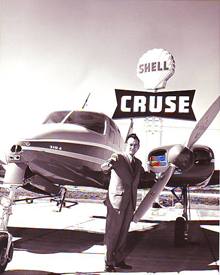Patrolling the Mexican Border by Air, Government and Private Enterprise Working Together. (original) (raw)
Shortly after World War II, the threat of invasion from Mexico was far different from the perceived threat today. Then the menace was disease. Mexican cattle infected with the dreaded hoof and mouth disease could easily wander (or be herded by smugglers) across the shallow, drought-stricken Rio Grande. Already rampant in Mexico, if the disease were to get a foothold in the U.S. it would be a huge economic disaster for Texas and the other border states - as well as the entire country. If you think of how serious the threat of Mad Cow disease is taken today, you'll have an idea of the seriousness of the problem back then.
 |
King Cruse in Houston, Texas, 1959 |
|---|
Former WWII pilot King Cruse of San Benito read where the cost of patrolling the border on horseback was $900 per mile per year. It was half that if the patrol were made by vehicle, but King knew flying and he knew that planes were far more efficient and cost effective than any vehicle. Cruse approached the U.S. Department of Agriculture and it sounded to them like an idea with wings. The best part about the proposition was that King came with his own fleet of planes.
The Ultimate Cattleguard King Cruse and his brother John ran San Benito Flying Service. While their fleet of Piper Cubs was less swift than the warplanes they flew during WWII, it was still flying - and to pilots - flying is living - even if it's just giving lessons or doing occasional aerial photography. The contract was written for San Benito Flying Service to furnish planes and pilots and the Bureau of Animal Industry would furnish observers. When cattle were spotted the pilots would dip as low as five feet to enable the government inspectors to read the brand or observe the animal's condition. If the animal was identified as diseased, a note would be dropped to a nearby government vehicle and the animal would be killed and burned where it stood.
The 2,400 mile U.S. - Mexico border was patrolled by seven of the Cruse Brothers' planes. These were stationed at their headquarters at San Benito and local airports at Laredo, Del Rio, Presidio, El Paso and Yuma, Arizona - many of them former U.S. airfields. Each plane had a range of 200 miles and a cruising speed of 75 miles per hour. It was estimated that at the peak of the program, Cruse planes logged 1,000,000 per year. Later in the program four-seater Cessna 170s replaced the two passenger Pipers.
Hoof and Mouth disease was contained in Mexico by 1952 and the program ended. The brothers continued operations as Cruse Air Inc. John Cruse died in 1976 and King ran the business until 1985. He passed away in 1996 but the name lives on. Cruse Air Parts, run by son Steve Cruse, exports airplane parts and equipment worldwide from their office in The Woodlands, Texas.
Steve Cruse has preserved his father's substantial photographic collection of the South Texas region and has supplemented it with vintage postcards - many of which he is now sharing with our readers in our Coastal town pages.
Texas Escapes, in its purpose to preserve historic, endangered and vanishing Texas, asks that anyone wishing to share their local history, stories, landmarks and recent or vintage photos, please contact us.